Pros
Cons
Introduction
Overall Design
{{section_header}}{{section.name}}{{/section_header}}
The Samsung LN55C630 is a good looking TV, like all the TVs Samsung manufactures. It's a company that takes design seriously, and we appreciate that. It also helps set Samsung apart from the competition, which now has to play catch-up.
Stand/Mount
{{section_header}}{{section.name}}{{/section_header}}
The stand is wide and flat, with an attractively beveled edge. It's quite sturdy, so you can feel secure even with a large, 55-inch panel sitting on top of it. The stand also allows the TV panel to swivel back and forth.

Controls
{{section_header}}{{section.name}}{{/section_header}}
The remote control that ships with the Samsung LN55C630 is comfortable and well-balanced, with a sensible arrangement of buttons. We really appreciate the backlighting feature that helps with operating the remote in a dark room. But why does the d-pad have be the only button that can't be lit from behind? Food for thought, Samsung.
Remote Control
{{section_header}}{{section.name}}{{/section_header}}
The Samsung LN55C630 has a series of touch-sensitive areas that control the basic TV functions. Because they're not true buttons, you are definitely likely to get fingerprints all over your pretty bezel – just a warning.

In the Box
{{section_header}}{{section.name}}{{/section_header}}
The Samsung LN55C630 ships with the TV, stand, remote control, batteries, a cleaning cloth, instructional manual, and assorted documentation.
Black Level
{{section_header}}{{section.name}}{{/section_header}}
The Samsung LN55C630 managed to produce a great black level – about 0.06 cd/m2. That's nearly as dark as what we've seen on some plasma TVs (as you can see from the Panasonic TC-P50G25 in chart below). And unlike the Samsung C530 series we reviewed earlier, there was no problem with actually seeing detail in the shadows. More on how we test black level.
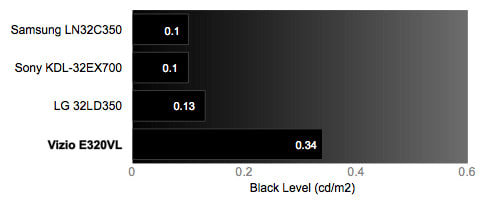
Peak Brightness
{{section_header}}{{section.name}}{{/section_header}}
The Samsung LN55C630 produced a solid performance in our peak brightness testing. With whites reaching 385.38 cd/m2, the TV will be plenty bright, even in a sunny room. As you can see in the chart below, LCD TVs usually don't have trouble with this test, but plasmas like the Panasonic rarely get as bright. More on how we test peak brightness.
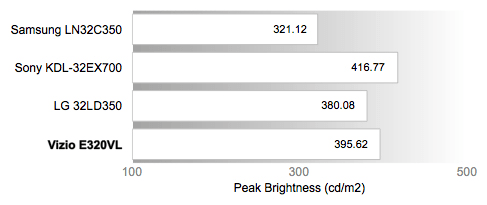
Contrast
{{section_header}}{{section.name}}{{/section_header}}
The Samsung LN55C630 produced a great contrast ratio of 6423:1. That's significantly wider than any of the other TVs we pulled in for this comparison pool. Of course, contrast isn't everything, but the LN55C630 did well in color performance too. It's shaping up to be quite the TV. More on how we test contrast.

Tunnel Contrast
{{section_header}}{{section.name}}{{/section_header}}
The Samsung LN55C630 showed only a slight problem maintaining a consistent black level. The issue is that as the amount of black content on the screen decreases, the black level can sometimes get brighter. As you can see in the chart below, it's not a perfectly linear problem. There's just a general inconsistency, but a definite trend line that goes up as the amount of black on the screen decreases. More on how we test tunnel contrast.
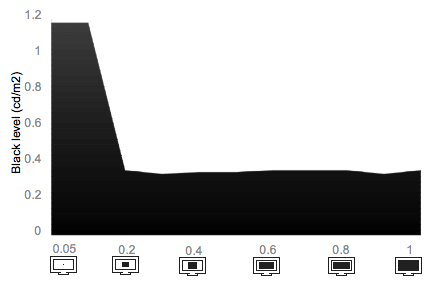
White Falloff
{{section_header}}{{section.name}}{{/section_header}}
The Samsung LN55C630 also showed a problem maintaining a consistent peak brightness. As the amount of white content on the screen decreases, and is surrounded by black, the brightness of that white decreases significantly. Usually LCDs don't have as much of a problem with this as plasmas, so the Samsung LN55C630 is a bit odd. More on how we test white falloff.
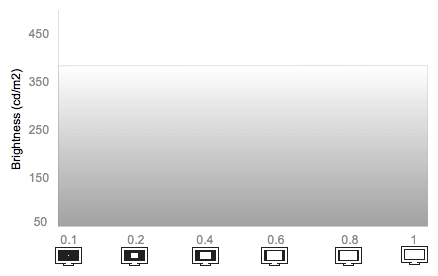
Uniformity
Greyscale Gamma
{{section_header}}{{section.name}}{{/section_header}}
The Samsung LN55C630's greyscale gamma test results were pretty good, but not perfect. Let's look at the chart below. The first thing we're looking at is the smoothness of the curve. Fortunately, that's quite good. We see almost no bumps or stretches where the line becomes flat. There's also the slope of the curve to consider. An ideal slope is between 2.1 and 2.2. The Samsung LN55C630's performance of 2.6 was a bit steep, which means you'll be missing some of the finer gradations in the greyscale spectrum. More on how we test greyscale gamma.
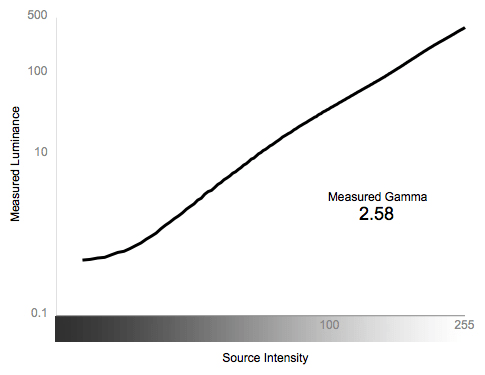
Color Temperature
{{section_header}}{{section.name}}{{/section_header}}
The Samsung LN55C630 had no trouble at all producing a consistent color temperature. As you can see in the chart below, the errors never strayed outside the range of human imperceptibility. More on how we test color temperature.

RGB Curves
{{section_header}}{{section.name}}{{/section_header}}
The Samsung LN55C630 produced very smooth color curves. If you look at the chart below, you can see the results of our testing. True, there are lots of little stair steps in the lines, but it's a fine enough gradation that you probably won't see much color banding. The shadows (lower left portion) are lacking a little in detail, and there some peaking in the highlights (upper right portion), but overall it's a strong performance. More on how we test RGB curves.

The strips below are digital recreations of the data above. You can see the Samsung LN55C630's performance compared to three similar TVs, as well as an ideal response curve.
Motion Performance
{{section_header}}{{section.name}}{{/section_header}}
Motion Smoothness (7.25)
The Samsung LN55C630's motion smoothness was pretty good, but susceptible to the same problems we see in all LCD TVs. There's a slight "stutter" that's particularly noticeable in high contrast foreground / background shots. The 120Hz processing helped give it an edge of Samsungs with 60Hz processing, as did the optional Auto Motion Plus feature. If you turn the feature on, almost all the typical LCD problems disappear, but it introduces a whole host of new problems. We recommend that you experiment with it, but ultimately leave it disabled. (More on how we test Motion.)
Motion Artifacting (8.5)
The Samsung LN55C630 didn't show too many artifacting issues. There's a slight, but noticeable, lag: when vertical objects move across the screen, they become a tad diagonal. If you enable the Auto Motion Plus feature you can improve the motion smoothness, but you'll introduce new types of artifacts. More on how we test motion performance.
3:2 Pulldown & 24fps
{{section_header}}{{section.name}}{{/section_header}}
The Samsung LN55C630 had no problem displaying native 24fps content, like you'd see in most Blu-Ray movies. More on how we test 3:2 pulldown and 24fps.
Resolution Scaling
{{section_header}}{{section.name}}{{/section_header}}
Samsung LN55C630 has a native 1080p (1920 x 1080) resolution, but much of the content that you'll be feeding the TV will be of a lower resolution. The TV's internal processing does the job of resizing that content so it fits the screen. Fortunately, it's very good at this job. More on how we test resolution scaling.
480p
The 480p content we viewed gave the Samsung LN55C630 the most trouble. It lost 2% of the top and bottom and 3% of the sides due to overscan.
720p
The 720p content displayed perfectly on the Samsung LN55C630.
1080i
The 1080i content also displayed with no problems.
Formats
{{section_header}}{{section.name}}{{/section_header}}
The Samsung LN55C630 has a native 1080p (1920 x 1080) display, but it can handle all standard NTSC formats. It also supports the xvYCC format, should you want to use it.
Viewing Angle
{{section_header}}{{section.name}}{{/section_header}}
The Samsung LN55C630 has an absolutely terrible viewing angle. We ran the test a few times to be sure, but there it is. The TV loses a significant amount of contrast after only 25 degrees (about 12 degrees from center in either direction). That's significantly narrower than the other LCD TVs in this comparison pool. Of course, it's completely defeated by the Panasonic, which is a plasma TV that is expected to have a wider viewing angle.
With a viewing angle this narrow, you'll need to consider the type of room you're putting the TV in. A wide, shallow room in which viewers will be spread out is definitely not the ideal situation.

Reflectance
{{section_header}}{{section.name}}{{/section_header}}
The Samsung LN55C630 has a highly reflective screen, but only if the light is coming in from a direct angle. If you can redirect either the light source or the screen, you'll save yourself a lot of trouble. When light hits straight on, the reflection takes on a starburst pattern that can be quite distracting.
Video Processing
{{section_header}}{{section.name}}{{/section_header}}
The Samsung LN55C630 has a number of video processing features, but most of them do more harm than good. The intriguing feature is definitely Auto Motion Plus, mostly because it makes film-based content so bizarre.
Calibration
{{section_header}}{{section.name}}{{/section_header}}
Once you put the Samsung LN55C630 in Movie mode, you'll already well on your way to the best picture quality. You can finish up by making the changes in the table below.

All of our calibration is done in conjunction with the DisplayMate software.
](http://www.displaymate.com/)
Video Modes
{{section_header}}{{section.name}}{{/section_header}}
The Samsung LN55C630 has a handful of video modes for one-touch changes that affect color, contrast, brightness, and more.
Connectivity
{{section_header}}{{section.name}}{{/section_header}}
Input Ports (7.0)
The Samsung LN55C630 has all the ports you need for a basic home theater set, plus a little extra. There are 4 HDMIs, a dedicated composite AV, a dedicated component AV, a shared composite/component AV, and a VGA input. You also get analog and digital audio outputs for all kinds of sound systems, and 2 USBs for connecting to USB mass storage devices or hard drives.
There's also an ethernet port and optional WiFi, but be aware that this is only for connecting to a DLNA home theater network. There is no option for streaming internet content. You need to step up to the Samsung LNxxC650 series or higher.

The ports are located on the back and side of the TV panel. Those on the side are made for quick swaps, like cameras, camcorders, and flash drives. Those in the back are for more permanent connections, and the swivel base makes them fairly easy to access.
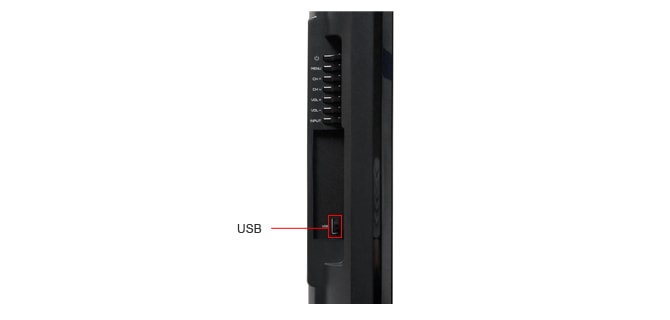
Output Ports (2.0)
The Samsung LN55C630 offers both a digital audio output and an analog audio output.
Other Connections (7.0)
The Samsung LN55C630 has an ethernet port and optional WiFi (with the additional purchase of a USB dongle). With them, you can connect to a DLNA home theater network. It does not, however, had access to streaming internet content or Samsung's app store.
Media (2.0)
The Samsung LN55C630 has two USB ports. Both can read USB mass storage devices (like flash drives and certain types of cameras, etc.), and one of the ports can read full-fledged USB hard drives. For more details on what you can do with this feature, jump ahead to Multimedia.
{{product.manufacturer_specs['Connectivity Tour Image 3']}}
Placement
{{section_header}}{{section.name}}{{/section_header}}
The Samsung LN55C630's ports are located on the back and side. Fortunately, the TV panel can swivel on its base, making it easier to access the ports on the rear.
Audio Quality
{{section_header}}{{section.name}}{{/section_header}}
The Samsung LN55C630 has average audio performance, neither terrible nor particularly impressive. Sure, you won't miss any details in the sound, but the bass response is a little muddy. The surround sound emulator doesn't do much, as far as we can tell. There's a five-channel equalizer, but it's not magically going to make the two speakers sounds like a high-end stereo. Most people will be satisfied using one of the five audio presets: Standard, Music, Movie, Clear Voice, and Amplify.
Menu Interface
{{section_header}}{{section.name}}{{/section_header}}
The Samsung menu system, shared amongst almost all the TVs, is among the best that we've seen. The organization is straightforward and effective. Main menu items are aligned vertically on the left side, and as you flip through the submenus, you almost always know where you are.

There are only occasional breaks in the structure, which can get a little confusing for newbies. Take the Picture Options menu, as seen below. If you get stuck anywhere in a menu, you and always use the Exit or Return button on the remote control.

Instruction Manual
{{section_header}}{{section.name}}{{/section_header}}
The instruction manual that comes with the Samsung LN55C630 is informative and fairly thorough, by the industry standards. There's at least a cursory explanation of every feature, and a table of contents and glossary to help you search more quickly. You can find the Samsung LN55C630's manual online here.

A manual for so many TV models, they have to be further categorized by type.
Internet Features
{{section_header}}{{section.name}}{{/section_header}}
The Samsung LN55C630 has no internet streaming features or access to the Samsung app store. However, you can use the ethernet port or optional WiFi (using a separately purchased USB dongle) to connect to a DLNA home theater network.
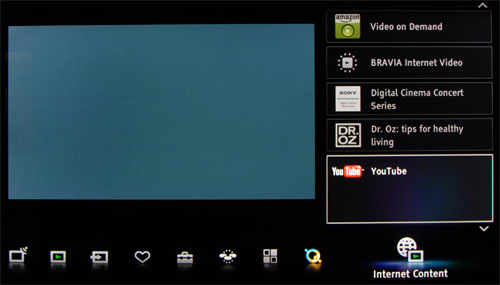
Local Media Playback
{{section_header}}{{section.name}}{{/section_header}}
The Samsung LN55C630 can play back photos from USB mass storage devices, like flash drives or certain types of cameras, as well as USB hard hard drives. When you plug in the device, the TV will ask you if you want to read the device. Select yes, and then it asks you to choose a media type: video, music, and photos.
You can view photos as thumbnails, one as a time, or in slideshows. There's also an option to add music files from the same device to play during the slideshow.
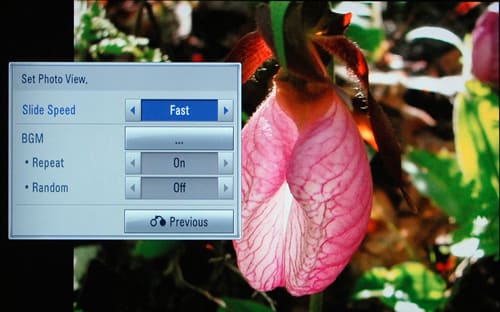
The Samsung LN55C630 can also play music and video files from USB devices. The interface is just like the photo playback, described above. For a complete list of compatible file types, read the instruction manual (online here).
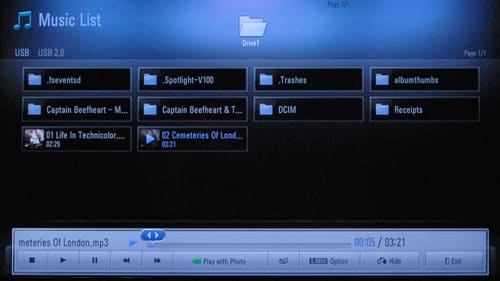
Other Media
{{section_header}}{{section.name}}{{/section_header}}
The Samsung LN55C630 does not support any other types of media.
Power Consumption
{{section_header}}{{section.name}}{{/section_header}}
The Samsung LN55C630's power consumption data is below.
The Samsung LN55C630 doesn't use that much power, considering how large the screen is. However, you can see how much more power a CCFL-backlit TV like this one uses compared to an LED-backlit TV like the Sony KDL-52EX700.
Value Comparison
{{section_header}}{{section.name}}{{/section_header}}
The Sony 52EX700 is a solid television with a great feature set, including DLNA support and access to Sony's great collection of streaming content. The Samsung LN55C630's contrast ratio was stronger, but Sony's viewing angle was much wider. Either choice is good one, and we recommend you vote based on cost.
Blacks & Whites
{{section_header}}{{section.name}}{{/section_header}}
The Samsung LN55C630 managed much deeper blacks than the Sony 52EX700, which contributed to a higher contrast ratio. Both TV can produce a bright enough screen that viewing in a sunny room will not be a problem.

Color Accuracy
{{section_header}}{{section.name}}{{/section_header}}
The Sony 52EX700 had a hard time maintaining a consistent color temperature, something the Samsung LN55C630 excelled at. However, they were both good at producing smooth color transitions.
Motion
{{section_header}}{{section.name}}{{/section_header}}
The Sony 52EX700 produced a smoother motion, but showed a little more artifacting.
Viewing Effects
{{section_header}}{{section.name}}{{/section_header}}
The Samsung LN55C630's viewing angle is terrible, and was easily beaten by the Sony 52EX700.
Connectivity
{{section_header}}{{section.name}}{{/section_header}}
The Samsung LN55C630 and Sony 52EX700 are almost evenly matched in the number of ports, but the Sony can do more with them, as it connect to internet streaming content features.
Other Comparisons
{{section_header}}{{section.name}}{{/section_header}}
The Sony 52EX700 offers access to Sony's outstanding collection of streaming content videos, apps, and music. It's the strongest in the market right now.
Value Comparison
{{section_header}}{{section.name}}{{/section_header}}
The Panasonic TC-P50G25 is a decent plasma TV, but the color performance had enough problems to give us pause. We loved the viewing angle, streaming content features, contrast, and feel of the TV, but it's not perfect. If you can find the Samsung for cheaper, it might be a better bet.
Blacks & Whites
{{section_header}}{{section.name}}{{/section_header}}
The Panasonic TC-P50G25, as a plasma TV, offers a much deeper black level – not that the Samsung LN55C630 was any slouch. But because the Samsung could get so much brighter, its contrast ratio was wider.

Color Accuracy
{{section_header}}{{section.name}}{{/section_header}}
The Panasonic managed a steady color temperature, but had a hard time producing smooth color curves, particularly brighter colors.
Motion
{{section_header}}{{section.name}}{{/section_header}}
Plasmas like the Panasonic P50G25 typically offer smoother motion than LCDs, but we noticed that this particular TV had some artifacting issues.
Viewing Effects
{{section_header}}{{section.name}}{{/section_header}}
Plasma TVs offer a far wider viewing angle than any LCD, and that was definitely the case here.
Connectivity
{{section_header}}{{section.name}}{{/section_header}}
The Panasonic P50G25 has one fewer HDMI, but adds an SD/SDHC/SDXC card slot that allows you to watch photos and movies from your camera or camcorder.
Other Comparisons
{{section_header}}{{section.name}}{{/section_header}}
The Panasonic TC-P50G25 offers access to Panasonic's collection of streaming content. It's not as good as Sony's, but with YouTube, Pandora, Picasa, Amazon on Demand, among others, there's plenty to watch and listen to.
Value Comparison
{{section_header}}{{section.name}}{{/section_header}}
The Vizio XVT553SV is a very good TV with a boatload of features, but you definitely pay for the privilege. Besides the price, we thought the black level and contrast were disappointing. You can boost the performance by a little with local dimming, but it has its side effects.
Blacks & Whites
{{section_header}}{{section.name}}{{/section_header}}
The Vizio XVT553SV had a hard time producing a decent black level, at least under our calibration settings. There are additional features you can enable to get deeper blacks, but we didn't like some of the side effects.

Color Accuracy
{{section_header}}{{section.name}}{{/section_header}}
The Vizio XVT553SV is a great color performer, something we weight heavily in our final evaluation.
Motion
{{section_header}}{{section.name}}{{/section_header}}
The Vizio XVT553SV showed a strong motion performance, with some minor artifacting problems that we see on most LCD TVs.
Viewing Effects
{{section_header}}{{section.name}}{{/section_header}}
The Vizio XVT553SV managed a great viewing angle, at least for an LCD. It far surpassed the Samsung LN55C630.
Connectivity
{{section_header}}{{section.name}}{{/section_header}}
The Vizio XVT553SV has one additional HDMI, but fewer legacy ports for older devices. We appreciate the build-in WiFi, which allows you access to Vizio's collection of streaming content.
Other Comparisons
{{section_header}}{{section.name}}{{/section_header}}
The Vizio XVT553SV offers access to their collection of streaming video and music content, as well as some apps for news, weather, etc.
Conclusion
There are a lot of reasons to like the Samsung LN55C630 ($1899 MSRP, approx. $1199 online). It has great contrast, a solid color performance, and the smooth design and interface we've come to expect from Samsung. But it's not the TV for everyone.
The LNxxC630 series has DLNA support, 120Hz processing, and some processing features that make it more expensive than other Samsung series. If you don't need these features, don't bother paying for them – the performance is largely the same in the C530 and C550 series. The Samsung LN55C630 also has a particularly bad viewing angle. If you need a TV for a wide, shallow room or for lots of people to watch at the same time (Super Bowl party?), this might not be the best choice.
If, however, you don't have those room restrictions, and you like DLNA support but don't care about the lack of streaming content or Samsung apps, this could make a great choice. Remember, there's no one-size-fits-all TV.
Model Series Comparison
{{section_header}}{{section.name}}{{/section_header}}
The Samsung LN55C630 has four models in the LNxxC630 series, all with relatively large screens. These are not entry level models – the refresh rate is faster and there's support for DLNA support. However, it lacks the features of high-end series like streaming content or even faster, 240Hz refresh rates.
Photo Gallery
{{photo_gallery "Front Tour Image", "Back Tour Image", "Sides Tour Image", "Stand Photo", "Controls Photo", "Remote Control Photo", "Connectivity Tour Image 1", "Connectivity Tour Image 2", "Connectivity Extra Photo", "Menu Main Photo", "Menu 2 Photo", "Internet Features 1 Photo", "Internet Features 2 Photo", "Internet Features 3 Photo", "Local Media Playback 1 Photo", "Local Media Playback 2 Photo"}}
Ratings & Specs
{{manufacturer_specs_table}}
Meet the tester
Robin Liss founded what is now Reviewed.com in 1996. In January 2011 she led the acquisition of the company by USA Today / Gannett.
Checking our work.
Our team is here to help you buy the best stuff and love what you own. Our writers, editors, and experts obsess over the products we cover to make sure you're confident and satisfied. Have a different opinion about something we recommend? Email us and we'll compare notes.
Shoot us an email